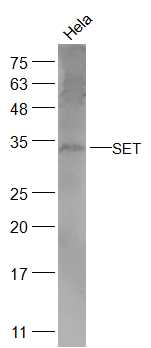
Rabbit Anti-SET antibody
SET_HUMAN; Protein SET; HLA-DR-associated protein II; Inhibitor of granzyme A-activated DNase (IGAAD); PHAPII; Phosphatase 2A inhibitor I2PP2A (I-2PP2A); Template-activating factor I (TAF-I); 2PP2A; IGAAD; MRD58; TAF-I; I2PP2A; IPP2A2; PHAPII; TAF-IBETA;
View History [Clear]
Details
Product Name SET Chinese Name SET易位蛋白/髓系白血病相关蛋白抗体 Alias SET_HUMAN; Protein SET; HLA-DR-associated protein II; Inhibitor of granzyme A-activated DNase (IGAAD); PHAPII; Phosphatase 2A inhibitor I2PP2A (I-2PP2A); Template-activating factor I (TAF-I); 2PP2A; IGAAD; MRD58; TAF-I; I2PP2A; IPP2A2; PHAPII; TAF-IBETA; Research Area Tumour immunology Immunogen Species Rabbit Clonality Polyclonal React Species Human, (predicted: Mouse, Rat, Chicken, Dog, Pig, Horse, Rabbit, Guinea Pig, ) Applications WB=1:500-2000 ELISA=1:5000-10000 IHC-P=1:100-500 IHC-F=1:100-500 IF=1:100-500 (Paraffin sections need antigen repair)
not yet tested in other applications.
optimal dilutions/concentrations should be determined by the end user.Theoretical molecular weight 32kDa Cellular localization The nucleus cytoplasmic Form Liquid Concentration 1mg/ml immunogen KLH conjugated synthetic peptide derived from human SET: 151-250/290 Lsotype IgG Purification affinity purified by Protein A Buffer Solution 0.01M TBS(pH7.4) with 1% BSA, 0.03% Proclin300 and 50% Glycerol. Storage Shipped at 4℃. Store at -20 °C for one year. Avoid repeated freeze/thaw cycles. Attention This product as supplied is intended for research use only, not for use in human, therapeutic or diagnostic applications. PubMed PubMed Product Detail The protein encoded by this gene inhibits acetylation of nucleosomes, especially histone H4, by histone acetylases (HAT). This inhibition is most likely accomplished by masking histone lysines from being acetylated, and the consequence is to silence HAT-dependent transcription. The encoded protein is part of a complex localized to the endoplasmic reticulum but is found in the nucleus and inhibits apoptosis following attack by cytotoxic T lymphocytes. This protein can also enhance DNA replication of the adenovirus genome. Several transcript variants encoding different isoforms have been found for this gene. [provided by RefSeq, Oct 2011].
Function:
Multitasking protein, involved in apoptosis, transcription, nucleosome assembly and histone binding. Isoform 2 anti-apoptotic activity is mediated by inhibition of the GZMA-activated DNase, NME1. In the course of cytotoxic T-lymphocyte (CTL)-induced apoptosis, GZMA cleaves SET, disrupting its binding to NME1 and releasing NME1 inhibition. Isoform 1 and isoform 2 are potent inhibitors of protein phosphatase 2A. Isoform 1 and isoform 2 inhibit EP300/CREBBP and PCAF-mediated acetylation of histones (HAT) and nucleosomes, most probably by masking the accessibility of lysines of histones to the acetylases. The predominant target for inhibition is histone H4. HAT inhibition leads to silencing of HAT-dependent transcription and prevents active demethylation of DNA. Both isoforms stimulate DNA replication of the adenovirus genome complexed with viral core proteins; however, isoform 2 specific activity is higher.
Subunit:
Isoform 1 and isoform 2 interact directly with each other and with ANP32A within the tripartite INHAT (inhibitor of acetyltransferases) complex. Isoform 1 and isoform 2 interact also with histones. Isoform 2 is a component of the SET complex, which also contains ANP32A, APEX1, HMGB2 and NME1, but not NME2. Within this complex, directly interacts with NME1 and with HMGB2. Interacts with SETBP1. Interacts with SGOL1. Interacts with APBB1.
Subcellular Location:
Cytoplasm, cytosol. Endoplasmic reticulum. Nucleus, nucleoplasm. Note=In the cytoplasm, found both in the cytosol and associated with the endoplasmic reticulum. Following CTL attack, moves rapidly to the nucleus, where it is found in the nucleoplasm, avoiding the nucleolus. Similar translocation to the nucleus is also observed for lymphocyte-activated killer cells after the addition of calcium. The SET complex is associated with the endoplasmic reticulum.
Tissue Specificity:
Widely expressed. Low levels in quiescent cells during serum starvation, contact inhibition or differentiation. Highly expressed in Wilms' tumor.
Post-translational modifications:
Isoform 2 is phosphorylated on Ser-15 and Thr-23.
Isoform 2 is acetylated on Lys-11.
Some glutamate residues are glycylated by TTLL8. This modification occurs exclusively on glutamate residues and results in a glycine chain on the gamma-carboxyl group.
N-terminus of isoform 1 is methylated by METTL11A/NTM1. Mainly trimethylated.
DISEASE:
Note=A chromosomal aberration involving SET is found in some cases of acute undifferentiated leukemia (AUL). Translocation t(6;9)(q21;q34.1) with NUP214/CAN.
Similarity:
Belongs to the nucleosome assembly protein (NAP) family.
SWISS:
Q01105
Gene ID:
6418
Database links:Entrez Gene: 6418 Human
Entrez Gene: 56086 Mouse
Entrez Gene: 671392 Mouse
SwissProt: Q01105 Human
SwissProt: Q9EQU5 Mouse
Product Picture
References (0)
No References
Bought notes(bought amounts latest0)
No one bought this product
User Comment(Total0User Comment Num)
- No comment



 +86 571 56623320
+86 571 56623320
 +86 18668110335
+86 18668110335

